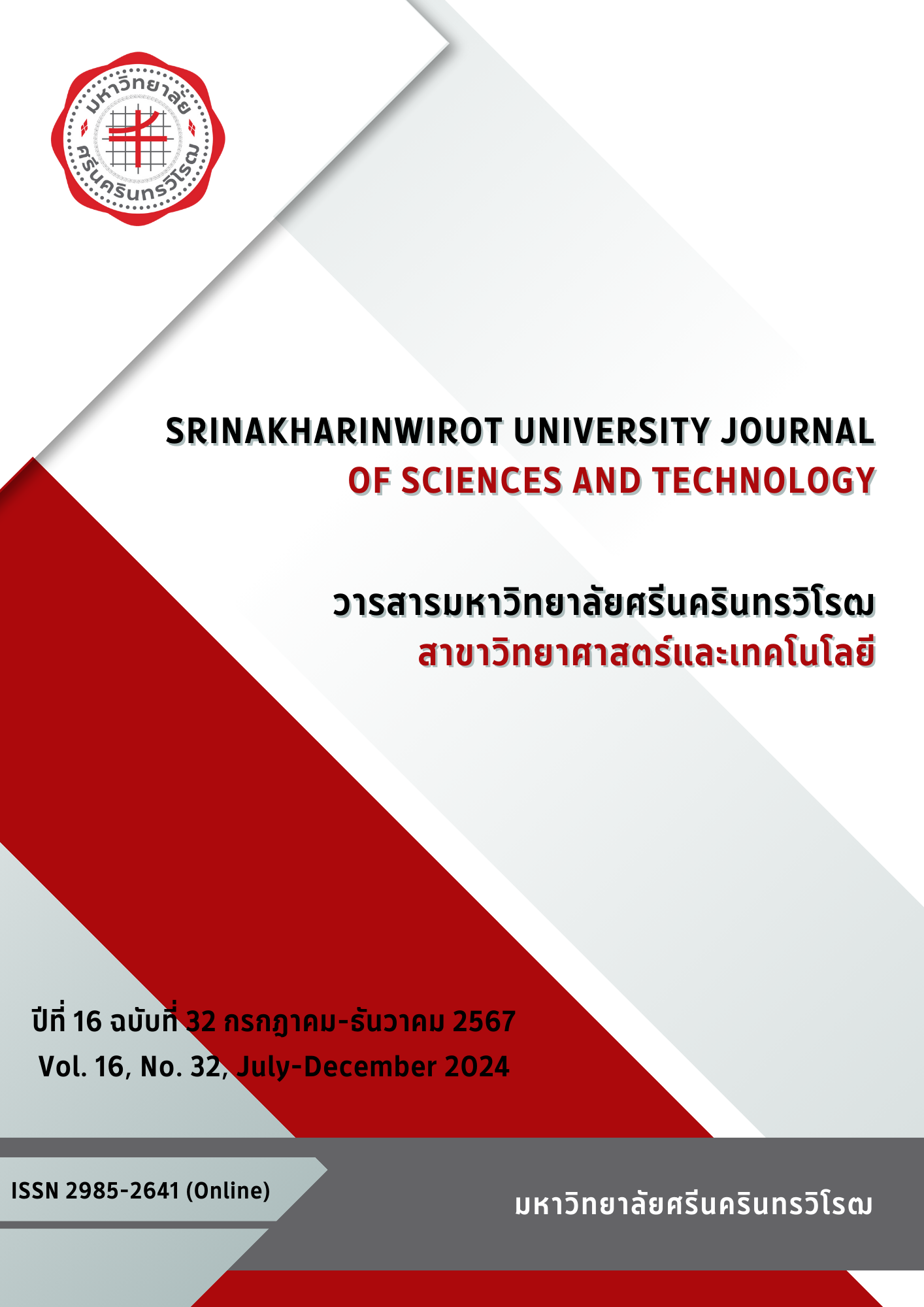EFFECT OF BINDER TYPE AND HEATING TIME TO QUALITY OF CONTAINER FROM UNGRADED MUSA BALBISIANA COLLA LEAVES
Keywords:
Musa balbisiana Colla, Enhancement, Banana Leaves, BinderAbstract
The aim of this study was to investigate the effect of the binder and heating time on the production of containers made from ungraded banana leaves. Before applying it to dried banana leaves, prepare a binder by combining wheat flour with three varieties of starch: tapioca starch, corn starch, and modified tapioca starch in a 3:1 ratio. It was formed at a temperature of 165ºC with three different heating times: 2 minutes, 2.5 minutes, and 3 minutes to form containers from banana leaves in the shape of round bowl with a diameter of 14 cm and a depth of 4 cm. The results of the investigation into the color properties of banana leaf containers following the molding procedure revealed that the molded containers showed hues of green-yellow. The variation in hue depends on the unprocessed materials prior to the molding process. Additionally, the binder and heating duration did not have any impact on the thickness and density measurements of containers made from banana leaves. There was not significantly difference (p<0.05) seen in the data across all testing conditions. Further, this condition has an impact on the mechanical properties and water absorption of the formed container. The containers produced with the C1 binder at a heating time of 2 minutes showed a substantially higher percentage of shape deformation upon applying force (p>0.05) compared to the containers made with the C2 and C3 binder formulations. Moreover, the extension of the heating time to 3 minutes resulted in a significant decrease in the elasticity of the container, becoming it less resistant to breakage. Consequently, this led to a substantial increase in the percentage of water absorption (p<0.05). In this case, the utilization of containers made from binder formulae C2 and C3, accompanied by a heating time of 2 minutes, seems to be suitable for the molding process. This material shows good tensile strength properties and demonstrates low tensile strain at maximum tensile stress. The molded container that is obtained may be utilized for packaging purposes and enhances the quality of products produced from low-grade Tanee banana leaves.
Downloads
References
Sirisak, P., and Suphunchaimat, N. (2011). Banana leaf production for trade at Klongkrajong sub-district, Sawankhalok district, Sukhothai province. Khon Kaen Agriculture Journal, 39(supplement), 478-482. (in Thai).
Sutthiyapiwat, S., and Phayoonpun, T. (2019). Design and development of food packaging form betel husk to add value for strong community and economic foundation. Princess of Naradhiiwad University Journal, 12(1), 120-131. (in Thai).
Mueangklang, K., Rakdanklang, N., Dongkrathok, N., Chanthinok, T., and Chidkarn, T. (2021). Natural recycled materials diecasting machine. Industrial Technology Journal, 6(2), 65-76. (in Thai).
Wongpoo, K., and Jewpanya, P. (2021). The Design and development of lotus leaves forming machine. RMUTL Engineering Journal, 6(1), 19-27. (in Thai).
On-ai, K., and Sonsaree, S. (2022). A study of the quality of banana leaf. Kasem Bundit Engineering Journal, 12(2), 35-50. (in Thai).
Ravindra, V. Gadhave, R., Mahanwar, P., and Gadekar, P. (2017). Starch-Based adhesives for wood/wood composite bonding: Review. Open Journal of Polymer Chemistry, 7, 19-32. https://doi.org/10.4236/ojpchem.2017.72002
Tratnik, N., Kuo, P.-Y., Tanguy, N. R., Gnanasekar, P., and Yan, N. (2020). Biobased epoxidized starch wood adhesives: Effect of amylopectin and amylose content on adhesion properties. ACS Sustainable Chemistry & Engineering, 8(49), 17997-18005.
https://doi.org/10.1021/acssuschemeng.0c05716
Kwanhong, P., Suwanchom, O., Srithanyarat, S., Songchan, K., and Singto, J. (2018). Influence of harvesting season and storage temperature on postharvest quality of fresh ‘TaNee’ banana leaves. Acta Horticulturae, 1210, 87-94. https://doi.org/10.17660/ActaHortic.2018.1210.12
Salleh, K. M., Hashim, R., Sulaiman, O., Hiziroglu, S., Wan Nadhari, W. N. A., Abd Karim, N., Jumhuri, N., and Ang, L. Z. P. (2015). Evaluation of properties of starch-based adhesives and particleboard manufactured from them. Journal of Adhesion Science and Technology, 29(4), 319-336. https://doi.org/10.1080/01694243.2014.987362
Bai, Y., Zhao, F., Shen, J., and Zhang, Y. (2021). Improvement of water resistance of wheat flour-based adhesives by thermal–chemical treatment and chemical crosslinking. Journal of Applied Polymer Science, 138(20), Article number 50458. https://doi.org/10.1002/app.50458
Nadhari, W. N. A. W., Ishak, N. S., Danish, M., Atan, S., Mustapha, A., Karim, N. A., Hashim, R., Sulaiman, O., and Yahaya, A. N. A. (2020). Mechanical and physical properties of binderless particleboard made from oil palm empty fruit bunch (opefb) with addition of natural binder. Materials Today: Proceedings, 31, 287-291. https://doi.org/10.1016/j.matpr.2020.06.009
Ramirez, R. J. C., Flores, F. T., Manuel, L. J. R., and Acabal, M. C. G. (2022). Effects of maturity, dipping time and drying method on selected physical and mechanical properties of dried saba (musa acuminate x balbisiana) leaves as packaging material. Philippine Journal of Agricultural and Biosystems Engineering, 16(1), 27-37.
Zakrajšek, N., and Golob, J. (2009), The influence of modified starch on the process water quality in papermaking and the paper properties. Starch, 61, 109-115. https://doi.org/10.1002/star.200800009
Silaket, P. (2017). Properties of modified cassava starch using amylase enzyme and octenyl succinic anhydride. Burapha Science Journal, 22(1), 108-124. (in Thai).
Downloads
Published
How to Cite
Issue
Section
License
Copyright (c) 2024 Srinakharinwirot University Journal of Sciences and Technology

This work is licensed under a Creative Commons Attribution-NonCommercial-NoDerivatives 4.0 International License.
Srinakharinwirot University Journal of Sciences and Technology is licensed Under a Creative Commons Attribution-NonCommercial-NoDerivs 4.0 International (CC-BY-NC-ND 4.0) License, Unless Otherwise Stated. Please Read Journal Policies Page for More Information on Open Access, Copyright and Permissions.



